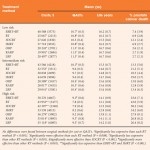Editorial: Valuing interventions for localised prostate cancer
Robert Pickard and Luke Vale
Governments of all nations struggle to work out how best to use the limited resources available for health care. One key area of uncertainty is long term conditions with multiple therapeutic options including no active treatment, where relative merits of different treatments are unclear and there is associated unexplained variation in use of often expensive interventions such as surgery. The management of localised prostate cancer typifies this situation. The problem is how to decide the relative worth of options especially as this judgement might differ between patients, clinicians, providers and funders. The best way is to perform well designed randomised trials between competing interventions with sufficient follow-up to identify any differences. For localised prostate cancer the ProTect trial is due to report in 2014. In the meantime, health care agencies commission Health Technology Assessments (HTA) to comparatively value interventions usually on the basis of the monetary cost of the added benefit they give in terms of better outcomes. This is commonly measured as the extra cost of each additional quality-adjusted life year (QALY) they give. The well laid out paper by Cooperberg et al. certainly adds to previous similar work that is available on relevant health agency websites (HTA 2003, CADTH 2011, HTA 2011, HTA 2012), but was interestingly funded by an industrial stakeholder, Intuitive Surgical. Given its perspective focusing predominantly on Medicare tariffs, it is perhaps most relevant to the US Government who pays these rates, but careful reading by all will at the very least give a flavour of the use of predictive statistical and economic modelling of the possible benefits to patients, and costs to funders of the treatments advised by clinicians.
It is important to highlight that the methods of meta-analysis of the existing literature used by Cooperberg et al. are unclear – this makes it hard to critique whether the best data have been used in the model. Furthermore, the data analyses are unusual. A more typical presentation would have been to explore the likelihood that each treatment would be considered cost-effective. The method used does not really illustrate whether the conclusion should be that there are no differences between treatments or whether there is insufficient evidence to determine whether there are differences. Furthermore, although baseline characteristics of patients included in the meta-analysis are not given it is likely that some would differ between men undergoing surgery or radiotherapy leading to bias in outcome. The linear Markov model used is also perhaps an inadequate reflection of reality since it does not appear to calculate QALYs for repeated transit through further cancer treatment/remission/recurrence states and between incontinent/continent and sexual dysfunction/no sexual dysfunction states which men would value specifically and independently. In terms of costs the have included costs of patient recovery time. Arguably recovery should be captured within the QALY measure and to include it again under costs might be an element of double counting. In addition they showed that the results were sensitive to certain assumptions that may be questioned such as the four year shorter time to metastasis after biochemical recurrence for radiotherapy.
Cooperberg et al. have certainly provided a useful example of how different treatments supervised by clinicians may be valued by those that pay the bills. A parting thought is if only clinicians of differing specialties could collaborate on large definitive RCTs we would not need to rely on predictive models based on imperfect data.
Robert Pickard is a Professor of Urology at the Institute of Cellular Medicine, Newcastle University, Newcastle upon Tyne, UK. email: robert.pickard@newcastle.ac.uk
Luke Vale is Health Foundation Chair in Health Economics at the Institute of Health & Society, Newcastle University, Newcastle upon Tyne, UK. email: luke.vale@newcastle.ac.uk




The trend of cost assessments using different models will continue until we take the advice from Rob Pickard and Luke Vale take on board that properly conducted RCTs are best way to answer these questions. Bodies like HTA have the responsibility to encourage such trials to justify adoption or otherwise of new technologies based on strong evidence rathen than intuition or fascination.
RCTs certainly provide the best evidence but can be cumbersome and expensive to perform partiuclarly for less common conditions. Alternatives are comparative cohort studies with independent adjudication of outcome, which although less robust than RCT, can provide quality evidence provided there is sufficient patient capture. Healthcare providers, professional organisations, patient groups and research funders should perhaps collaborate more effectively to better use the resources we already have available.